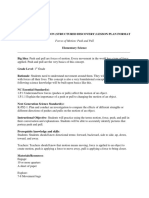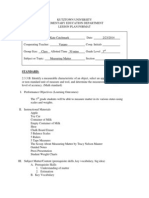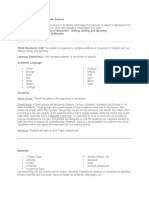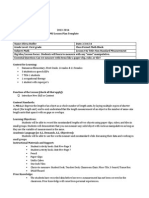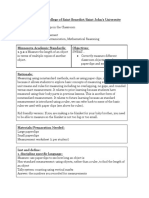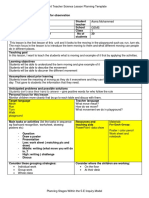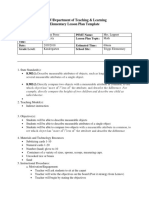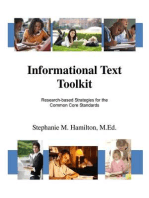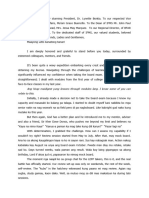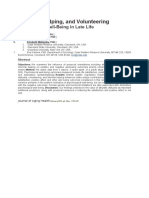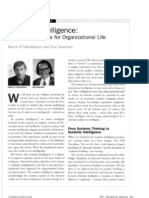0 ratings0% found this document useful (0 votes)
58 viewsLesson 3 - Unit
Lesson 3 - Unit
Uploaded by
api-242431906Copyright:
© All Rights Reserved
Available Formats
Download as DOCX, PDF, TXT or read online from Scribd
Lesson 3 - Unit
Lesson 3 - Unit
Uploaded by
api-2424319060 ratings0% found this document useful (0 votes)
58 views6 pagesOriginal Title
lesson 3- unit
Copyright
© © All Rights Reserved
Available Formats
DOCX, PDF, TXT or read online from Scribd
Share this document
Did you find this document useful?
Is this content inappropriate?
Copyright:
© All Rights Reserved
Available Formats
Download as DOCX, PDF, TXT or read online from Scribd
Download as docx, pdf, or txt
0 ratings0% found this document useful (0 votes)
58 views6 pagesLesson 3 - Unit
Lesson 3 - Unit
Uploaded by
api-242431906Copyright:
© All Rights Reserved
Available Formats
Download as DOCX, PDF, TXT or read online from Scribd
Download as docx, pdf, or txt
You are on page 1of 6
13
Elements of the Lesson
Evidence that Documents the Elements
Standard
MDE grade level or CCSS
P.PM.02.13- Measure the length of objects using rulers (centimeters) and meter sticks.
S.IP.02.13- Plan and conduct simple investigations.
S.IA.02.12- Share ideas about science through purposeful conversation.
S.IA.02.13- Communicate and present findings of observations.
S.IA.02.14- Develop strategies and skills for information gathering and problem solving (books,
internet, ask an expert, observation, investigation, technology tools.)
M.UN.02.01- Measure lengths in meters, centimeters, inches, feet, and yards approximating to the
nearest whole unit and using abbreviation: cm, m, in, ft, yd.
Objectives/Targets
What am I going to teach?
What will the students be able to do at the end of the lesson?
How will the objectives be assessed?
(formal and informal evidence)
I can measure the length of objects using rulers and meter sticks.
TLW measure the length of objects using rulers and meter sticks.
I can plan and conduct investigations.
TLW plan and conduct simple investigations.
I can share ideas about science to my partner, and class.
TLW share ideas about science to my partner, and class.
I can tell about my findings from observations.
TLW tell about their findings from observations.
I can gather information and problem solve by conducting observations.
I can measure lengths in the appropriate unit, and use abbreviations such as, cm, and in.
TLW measure lengths in appropriate units and use the appropriate abbreviation.
Anticipatory Set
How will my students be motivated, interested, or focused?
What prior knowledge is necessary?
What practice(s) will be implemented?
Session One:
(Connecting) Explain to students that we have been learning about all kinds of
different ways to measure different body parts, and objects. What measuring
materials have we used so far? Allow students time to answer. Today we are
going to continue our measurement unit by using some new material and new
concepts.
Display the Move and Balance Bag for students so they can look at the items in
the bag.
Display the ramp at the front of the classroom.
The items may contain objects such as; balls, blocks, empty containers, and
toys.
The teacher will ask students which items they think will roll down the ramp.
Allow time for students to discuss with a partner, and then share as a whole
group.
The teacher will write on the board or make a chart called, Moving Objects
Chart. On this chart there will be three columns. The first needs to be labeled,
Lesson Three: How Far Will it Roll?
14
what we think. The second is labeled, How can we find out? And, the last one
is labeled, What do we conclude. (Note: this chart will be completed throughout
the lesson.)
For the anticipatory set, the students will share what they think will happen, and
the teacher will record it on the chart.
Input
Task analysis:
What information does the learner need? If needed
how will it be provided?
How is the lesson scaffolded?
Thinking levels: questions to engage students thinking
Remembering
Understanding
Applying
Analyzing
Evaluating
Creating
Accommodations: implementing differentiation principles
Remediation
Extension
Learning styles
Managing the lesson
Instructional methods
Engagement strategies
Materials needed and prepared
Task Analysis (2 class sessions, 30 minutes each)
Session One
Gather students to the carpet.
Complete the anticipatory set with the students.
Go over what the term force means with the students.
Allow students the time to think about what the word force means. Have them
share with a partner, and then share as a whole group.
As a class, we will come up with a definition together, and write it on the board.
Tell the students that they will be doing an experiment with the ramp and the
Move and Balance Bags.
The teacher will show and explain the activity sheet underneath the elmo. Under
object, the teacher will write ball, and predict whether the object rolled or slid
down the ramp.
The teacher will choose the ball to use to model. The teacher will have a timer
ready to record when the ball leaves the ramp.
Then go back to the activity chart, and fill out the, How Can We Find Out?
column. We will record how we can find out how to figure out how far the ball will
travel down the ramp.
The teacher will release the ball at the top of the ramp.
Record what we conclude on the Moving Objects Chart.
Return to the activity sheet, and record if the object did roll or slide.
The teacher will then measure the distance the ball traveled once it was
completely off the ramp. So the distance measured will be the distance that the
ball appeared to be off the ramp, to where it stopped rolling on the ground. The
teacher will model how to measure this and ask students what she should do to
measure how far the ball traveled.
o How do I measure how far the ball traveled? (You start at the bottom of
the ramp to where the ball ended up.
o Where do I start measuring with my meter stick? Do I start at a certain
number? (No, you start at the end of the meter stick before the numbers
start at one.)
15
o The teacher will then measure the distance from the bottom of the ramp
to where the ball ended up.
The teacher will then record the distance and time onto the activity sheet.
Session Two:
The teacher will briefly recap on what the students will be doing, and will call on
students to explain what they will be doing during this activity.
Students will be assigned to groups. There will be around 6 students in each
group. They will grab a board for their ramp, a timer for their group, and a move
and balance bag. The students will have different jobs. One student will hold up
their ramp, one will record time, two will measure distance, and two will slide
objects down the ramp. (Note: some groups will be smaller than 6 students, so
this will be need to be adjusted for them.) The jobs will be assigned to
themthey will not be able to pick for this causes too much argumentation.
The teacher will model the jobs for the students. The teacher will call up 5
students to volunteer. She will assign those students their jobs. 1 person will
hold the ramp, one will record time, two will measure distance, and two will slide
objects down the ramp. The teacher will then do a trial run with the ball with this
group in front of the classroom so that students understand what the jobs will
look like.
After giving students time to complete their experiment, gather them back to the
carpet to discuss their findings. Have students raise their hands to share some of
their findings.
Ask the students whether or not the height of their board/ramp affected the
results of the distance and time. Allow students time to discuss this with one
another, and then pull back to whole group for class discussion.
The teacher will then explain the rest of the activity sheet to the students, and
model #1 on the backside of the sheet. Draw a picture of the ball, and label how
you tested the balls distance, and time.
Dismiss students to go back to their seats to complete the rest of the activity
sheet.
The teacher will collect their worksheets once the students are done.
Thinking Levels:
Remembering: students will remember what objects traveled the farthest and
fastest by recording their data onto their activity sheets.
Applying: students will apply what they have been learning by completing page
two of their activity sheets.
16
Accommodations:
Remediation- if this lesson is too difficult, students will be offered assistance to
help complete the experiment. They will also ask their group members for help
when they need it.
Extensions- have students find another object from the classroom or from home
that they think will move down the ramp faster and farther than the objects
tested. Ask the students to tell why they think it will move faster and farther and
what they would do to test their ideas.
Learning Styles
o There is a wide range of learning styles in the classroom. Many students
are hands on, and many of them can do hands on or just listening to the
teacher when learning.
o When using hands on learning, students have a better chance to retain
the information, because they are applying what they are learning.
Managing the lesson:
Students will raise their hands when they want to share their thinking.
The teacher will explain all directions to the students while they are still at the
carpet.
While the students are doing their experiment, the teacher will continuously walk
around to make sure all students are engaged throughout the lesson. The
teacher will also ask questions to ensure that they are engaged.
Materials Needed:
o Activity Sheet for each student
o 4 ramps/boards
o 4 measuring tapes
o 4 meter sticks
o 4 stop watches
o 4 move and balance bags
Modeling
Provide details of what you will say and what you will do
Visual input accompanied by verbal input
Session One:
The teacher will show and explain the activity sheet underneath the elmo. Under
object, the teacher will write ball, and predict whether the object rolled or slid
down the ramp.
The teacher will choose the ball to use to model. The teacher will have a timer
ready to record when the ball leaves the ramp.
Then go back to the activity chart, and fill out the, How Can We Find Out?
17
column.
The teacher will release the ball at the top of the ramp.
Record what we conclude on the Moving Objects Chart.
Return to the activity sheet, and record if the object did roll or slide.
The teacher will then measure the distance the ball traveled once it was
completely off the ramp. So the distance measured will be the distance that the
ball appeared to be off the ramp, to where it stopped rolling on the ground.
The teacher will then record the distance and time onto the activity sheet.
Session Two:
The teacher will then explain the rest of the activity sheet to the students, and
model #1 on the backside of the sheet. Draw a picture of the ball, and label how
you tested the balls distance, and time.
Checking for Understanding
Samples of questions to be asked
Ways in which students will respond and be engaged
Formative assessment strategies to be implemented
What do we think will happen to the ball once its released on the ramp?
o Possible Answers: I think the ball will travel fast.
I think the ball will travel far.
The teacher will walk around the room and assist students who need extra help
with this lesson.
While walking around the teacher will make sure that all students are
participating, and the teacher will ask questions to see if the students are
completing their experiments.
o Possible Questions: What object are you measuring now?
o Lets see your activity sheet.
o How far do you think your ball will travel?
Guided Practice
What do the teacher and student do together?
Modeling first then with a gradual release of responsibility
The teacher and the student will complete the Moving Objects Chart together.
After the teacher models the experiment, the students will be released to
complete their experiments with their group.
Once students are finished with their experiments, students will complete the
rest of their activity sheet on their own.
Independent Practice (if applicable)
Students will complete page two of their activity sheet on their own.
Closure
Wrap up the lesson; summarize is one way
Students will complete page two of their activity sheet on their own. This will
recap what students have learned about their experiment.
18
Assessment
What evidence supports that the objective(s) were met?
What do my students know, understand and are able to do?
Using your assessment data, what will you change?
Formative
Students will do the rest of their activity sheet, and turn in. The teacher will check
to see if the students understood the experiment, and material presented to
them.
Reflection
How well did the students perform?
Were all students engaged?
How was my timing?
How was my instruction received? What should be modified?
Were all my students engaged?
Was this lesson to hard for them?
Did I manage the lesson well?
Did my students understand the experiment?
What should be modified?
You might also like
- Julie Nicholson, Julie Kurtz, Lafeshia Edwards, Jonathan Iris-Wilbanks, Samantha Watson-Alvarado, Maja Jevgjovikj, Valentina Torres - Supporting Young Children To Cope Build Resilience and Heal From TDocument221 pagesJulie Nicholson, Julie Kurtz, Lafeshia Edwards, Jonathan Iris-Wilbanks, Samantha Watson-Alvarado, Maja Jevgjovikj, Valentina Torres - Supporting Young Children To Cope Build Resilience and Heal From TNNo ratings yet
- First Grade Measurement Lesson PlanDocument3 pagesFirst Grade Measurement Lesson Planapi-23936759880% (5)
- Personal Counselling TheoryDocument19 pagesPersonal Counselling Theoryapi-289910399100% (2)
- Kindergarten Measurement Lesson PlanDocument4 pagesKindergarten Measurement Lesson Planapi-351597723No ratings yet
- Push An Pull Lesson PlanDocument6 pagesPush An Pull Lesson Planapi-381352626No ratings yet
- Lesson Plan - Fms Catch and ThrowDocument7 pagesLesson Plan - Fms Catch and Throwapi-264509853No ratings yet
- Measuring Matter Lesson PlanDocument4 pagesMeasuring Matter Lesson Planapi-252742039No ratings yet
- Lesson Plan How Big Is A FootDocument3 pagesLesson Plan How Big Is A Footapi-341334054No ratings yet
- Lesson Plan What Is An InchDocument6 pagesLesson Plan What Is An Inchapi-343678808No ratings yet
- Lesson Plan - MathsDocument4 pagesLesson Plan - Mathsapi-250080978No ratings yet
- Lessonplan 3Document3 pagesLessonplan 3api-485134991No ratings yet
- Lesson Plan ProjectDocument7 pagesLesson Plan ProjectStephanie AvilaNo ratings yet
- ST Lesson 1Document3 pagesST Lesson 1api-303015163No ratings yet
- Lesson 4 - UnitDocument6 pagesLesson 4 - Unitapi-242431906No ratings yet
- Teach 2 RevisedDocument10 pagesTeach 2 Revisedapi-273147283No ratings yet
- Unit 6Document4 pagesUnit 6api-245823147No ratings yet
- Lesson Plan Triceratops FootDocument8 pagesLesson Plan Triceratops Footapi-306675138No ratings yet
- Stoffer Early Childhood Plans For Learning SegmentDocument7 pagesStoffer Early Childhood Plans For Learning Segmentapi-253427643No ratings yet
- How To Make A RulerDocument4 pagesHow To Make A RulerJaime FurstNo ratings yet
- Lesson Plan - Place ValueDocument3 pagesLesson Plan - Place Valueapi-302003110No ratings yet
- How Does Toy MoveDocument3 pagesHow Does Toy Moveapi-254791533No ratings yet
- 2016 Chunk Lesson Plan Template-3Document3 pages2016 Chunk Lesson Plan Template-3api-316871285No ratings yet
- Area and PerimeterDocument3 pagesArea and Perimeterapi-285970439No ratings yet
- Lesson Plan College of Saint Benedict/Saint John's UniversityDocument6 pagesLesson Plan College of Saint Benedict/Saint John's Universityapi-338927224No ratings yet
- Appendix 1: Lesson Plan (Template) : MST: MR - LorcanDocument4 pagesAppendix 1: Lesson Plan (Template) : MST: MR - Lorcanapi-374921761No ratings yet
- Gravity Rules! Integrated Math and Science Lesson PlanDocument3 pagesGravity Rules! Integrated Math and Science Lesson Planapi-284879704No ratings yet
- Lesson Plan Form Udl Fa14 Lesson 2Document4 pagesLesson Plan Form Udl Fa14 Lesson 2api-300681621No ratings yet
- Student Teacher: Angela Walter Subject(s) : Math Unit: Unit 5 Lesson Title: Two Step Word Problems in Everyday Life Grade: 3 1. StandardsDocument4 pagesStudent Teacher: Angela Walter Subject(s) : Math Unit: Unit 5 Lesson Title: Two Step Word Problems in Everyday Life Grade: 3 1. Standardsapi-292193880No ratings yet
- Cup Stacking and Hula Hoop Lesson PlanDocument6 pagesCup Stacking and Hula Hoop Lesson Planapi-282897455No ratings yet
- Reflective Lesson Plan-MathDocument13 pagesReflective Lesson Plan-Mathapi-217594944No ratings yet
- Joint Lesson, Experiment, & Activity: Ccss - Ela-Literacy.W.3.8 Ccss - Ela-Literacy.W.3.2Document6 pagesJoint Lesson, Experiment, & Activity: Ccss - Ela-Literacy.W.3.8 Ccss - Ela-Literacy.W.3.2api-301426684No ratings yet
- Formal Lesson Plan 4Document5 pagesFormal Lesson Plan 4api-383424069No ratings yet
- Math Lesson Plan - Finding PerimeterDocument12 pagesMath Lesson Plan - Finding Perimeterapi-302768850No ratings yet
- Formal Lesson 2 - MathDocument9 pagesFormal Lesson 2 - Mathapi-271874263No ratings yet
- Geralynn Otero Final Lesson PlanDocument5 pagesGeralynn Otero Final Lesson Planapi-644888167No ratings yet
- Mass Influence On Force Lesson PlanDocument3 pagesMass Influence On Force Lesson Planapi-283344745No ratings yet
- MeasurementDocument5 pagesMeasurementapi-273875610No ratings yet
- Lesson Plan (Measurment)Document7 pagesLesson Plan (Measurment)Lindsey_pelletier#No ratings yet
- Math Lesson PlanDocument5 pagesMath Lesson Planapi-302133453No ratings yet
- Math LessonDocument4 pagesMath Lessonapi-645343769No ratings yet
- Math Field LessonsDocument11 pagesMath Field Lessonsapi-337179959No ratings yet
- Pre-Student Teaching Lesson PlanDocument15 pagesPre-Student Teaching Lesson Planapi-346855151No ratings yet
- Maths 3d Shapes - Lesson PlanDocument7 pagesMaths 3d Shapes - Lesson Planapi-337839493No ratings yet
- Unit: Push and Pull in Play GroundDocument3 pagesUnit: Push and Pull in Play Groundapi-254791533No ratings yet
- 2nd Grade Math Measurement UnitDocument8 pages2nd Grade Math Measurement Unitcjcampbell08No ratings yet
- Non-Standred Measuement-Lesson PlanDocument4 pagesNon-Standred Measuement-Lesson Planapi-335617097No ratings yet
- Thematic Unit ThanksgivingDocument5 pagesThematic Unit Thanksgivingapi-254465169No ratings yet
- Dawn Gruber Lesson Plan Portfolio EDU 565-900 Spring 2013Document12 pagesDawn Gruber Lesson Plan Portfolio EDU 565-900 Spring 2013api-278234953No ratings yet
- Ready, Set, Teach Lesson Plan Format #3: StandardsDocument5 pagesReady, Set, Teach Lesson Plan Format #3: Standardsapi-305616443No ratings yet
- Developmental Lesson Plan: Common Core/PA Standard(s)Document8 pagesDevelopmental Lesson Plan: Common Core/PA Standard(s)api-434208019No ratings yet
- Lesson 1 Unit PlanDocument4 pagesLesson 1 Unit Planapi-300384449No ratings yet
- LessonplanDocument6 pagesLessonplanapi-328593738No ratings yet
- Underhand Lesson Plan 2017Document4 pagesUnderhand Lesson Plan 2017api-346302593No ratings yet
- Lesson Plan Year 8 Maths Cartesian CoordinatesDocument3 pagesLesson Plan Year 8 Maths Cartesian Coordinatesapi-269319313No ratings yet
- UNLV/Department of Teaching & Learning Elementary Lesson Plan TemplateDocument3 pagesUNLV/Department of Teaching & Learning Elementary Lesson Plan Templateapi-403209118No ratings yet
- Joints Lesson PlanDocument4 pagesJoints Lesson Planapi-3246566340% (1)
- Lesson 2 Mason and BryanDocument12 pagesLesson 2 Mason and Bryanapi-711193254No ratings yet
- Informational Text Toolkit: Research-based Strategies for the Common Core StandardsFrom EverandInformational Text Toolkit: Research-based Strategies for the Common Core StandardsNo ratings yet
- Elementary Science Experiments: Analyzing Data to Make PredictionsFrom EverandElementary Science Experiments: Analyzing Data to Make PredictionsNo ratings yet
- The Seven T's of Practical Differentiation: Alphabet Sevens, #2From EverandThe Seven T's of Practical Differentiation: Alphabet Sevens, #2Rating: 5 out of 5 stars5/5 (1)
- Jos 2023Document118 pagesJos 2023anggawiditamaNo ratings yet
- Oral Communication - Subject AppreciationDocument16 pagesOral Communication - Subject AppreciationJessa BaylonNo ratings yet
- Dynamics of Inter and Intrapersonal Relations ReviewerDocument11 pagesDynamics of Inter and Intrapersonal Relations ReviewerRoanne DomanNo ratings yet
- NSTP 6101 Prelim Quiz 1Document2 pagesNSTP 6101 Prelim Quiz 1Mark JuarezNo ratings yet
- Factors Affecting Knowledge Sharing Behavior Among Stakeholders in Jordanian Hospitals Using Social NetworksDocument10 pagesFactors Affecting Knowledge Sharing Behavior Among Stakeholders in Jordanian Hospitals Using Social NetworksBenjamin DanielNo ratings yet
- Recognition Speech (Bisaya and English)Document3 pagesRecognition Speech (Bisaya and English)Kaye NecesarioNo ratings yet
- Teaching Approaches and MethodsDocument3 pagesTeaching Approaches and MethodsKenneth Delos SantosNo ratings yet
- College of Health Sciences Nurse Patient Interaction: Kabacan, Cotabato PhilippinesDocument2 pagesCollege of Health Sciences Nurse Patient Interaction: Kabacan, Cotabato PhilippinesIvy CampuganNo ratings yet
- Families in Extreme PovertyDocument2 pagesFamilies in Extreme Povertyapi-390302132No ratings yet
- Bandura Observational Learning TheoryDocument27 pagesBandura Observational Learning TheoryEmy Daet GeneralNo ratings yet
- Field Study 1: Learning Episode FS1 7Document7 pagesField Study 1: Learning Episode FS1 7Mikee GallaNo ratings yet
- Political Thought and Political Thinkers (Judith N. Shklar (Auth.) Etc.) (Z-Library)Document214 pagesPolitical Thought and Political Thinkers (Judith N. Shklar (Auth.) Etc.) (Z-Library)Mike Alegrete CrespoNo ratings yet
- Kumpulan Jurnal Internasional AltruismeDocument18 pagesKumpulan Jurnal Internasional AltruismeInsan ChanNo ratings yet
- Egeberg, H., McConney, A., & Price, A.Document20 pagesEgeberg, H., McConney, A., & Price, A.Isabel BuntingNo ratings yet
- Chapter 03 Prepu PsychDocument172 pagesChapter 03 Prepu PsychnanaNo ratings yet
- Abra Elementary School: Santiago CityDocument5 pagesAbra Elementary School: Santiago CityMarjorie Delrosario Pilon100% (1)
- Festinger (1956) : When Prophecy FailsDocument2 pagesFestinger (1956) : When Prophecy FailssaragbNo ratings yet
- Systems Intelligence:: A Key Competence For Organizational LifeDocument11 pagesSystems Intelligence:: A Key Competence For Organizational LifeDaisyNo ratings yet
- Leadership Style Term PaperDocument31 pagesLeadership Style Term Paperjemichoobale0106No ratings yet
- What Is Autonomy?: SectionDocument19 pagesWhat Is Autonomy?: SectionRichard HazingtonNo ratings yet
- Zizek DescartesDocument25 pagesZizek DescartesMatteo de DonatoNo ratings yet
- Team Building GamesDocument156 pagesTeam Building GamesfancifyierNo ratings yet
- Strengths-Based Leadership Insight Report: Leader: Bianca MateiDocument5 pagesStrengths-Based Leadership Insight Report: Leader: Bianca MateiBianca Elena MateiNo ratings yet
- Chapter IIIDocument11 pagesChapter IIIAbdul R. SidikNo ratings yet
- Episode 2 SheineDocument14 pagesEpisode 2 SheineClaire Parangipang ChuaNo ratings yet
- Stative Verbs ListDocument5 pagesStative Verbs ListAlice100% (1)
- Learning: Any Relatively Permanent Change in Behavior or Behavior Potential Caused by Reinforced Practice or ExperienceDocument10 pagesLearning: Any Relatively Permanent Change in Behavior or Behavior Potential Caused by Reinforced Practice or ExperiencePatricia Danise VolanteNo ratings yet
- 4as LESSON PLAN - TEMPLATEDocument6 pages4as LESSON PLAN - TEMPLATEAljohn LumapasNo ratings yet




